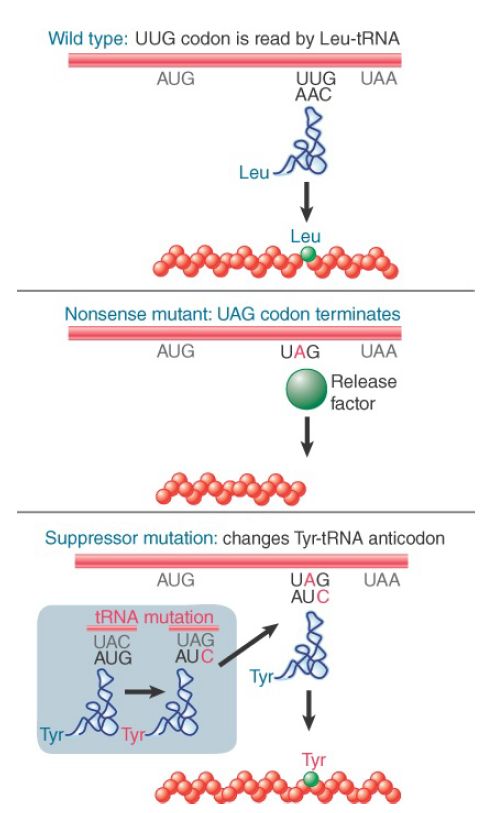
Suppressor tRNAs Have Mutated Anticodons That Read New Codons
 المؤلف:
JOCELYN E. KREBS, ELLIOTT S. GOLDSTEIN and STEPHEN T. KILPATRICK
المؤلف:
JOCELYN E. KREBS, ELLIOTT S. GOLDSTEIN and STEPHEN T. KILPATRICK
 المصدر:
LEWIN’S GENES XII
المصدر:
LEWIN’S GENES XII
 الجزء والصفحة:
الجزء والصفحة:
 1-6-2021
1-6-2021
 2320
2320
Suppressor tRNAs Have Mutated Anticodons That Read New Codons
KEY CONCEPTS
- A suppressor tRNA typically has a mutation in the anticodon that changes the codons that it recognizes.
- When the new anticodon corresponds to a termination codon, an amino acid is inserted and the polypeptide chain is extended beyond the termination codon. This results in nonsense suppression at a site of nonsense mutation or in readthrough at a natural termination codon.
- Missense suppression occurs when the tRNA recognizes a different codon from usual so that one amino acid is substituted for another.
Isolation of mutant tRNAs has been one of the most potent tools for analyzing the ability of a tRNA to recognize its codon(s) in mRNA and for determining the effects that changes in different parts of the tRNA molecule have on codon–anticodon recognition.
Mutant tRNAs are isolated by virtue of their ability to overcome the effects of mutations in genes encoding polypeptides. In genetic terminology, a mutation that is able to overcome the effects of another mutation is called a suppressor.
In tRNA suppressor systems, the primary mutation changes a codon in an mRNA so that the polypeptide product is no longer functional. The secondary suppressor mutation changes the anticodon of a tRNA so that it recognizes the mutant codon instead of (or as well as) its original target codon. The amino acid that is now inserted restores polypeptide function. The suppressors are described as nonsense suppressors or missense suppressors, depending on the nature of the original mutation.
A nonsense mutation converts a codon that specifies an amino acid to one of the three stop codons. In a wild-type cell, such a nonsense mutation is recognized only by a release factor, which terminates translation. However, the second suppressor mutation in the tRNA anticodon creates an aminoacyl-tRNA that can recognize the termination codon. By inserting an amino acid, the second-site suppressor allows translation to continue beyond the site of nonsense mutation. This new capacity of the translation system allows a full-length polypeptide to be synthesized, as illustrated in FIGURE 1. If the amino acid inserted by suppression is different from the amino acid that was originally present at this site in the wild-type polypeptide, the activity of the polypeptide may be altered.

FIGURE 1. Nonsense mutations can be suppressed by a tRNA with a mutant anticodon, which inserts an amino acid at the mutant codon, producing a full-length polypeptide in which the original Leu residue has been replaced by Tyr.
Missense mutations change a codon representing one amino acid into a codon representing another amino acid—one that cannot function in the polypeptide in place of the original residue. (Formally, any substitution of amino acids constitutes a missense mutation, but in practice it is detected only if it changes the activity of the polypeptide.) The mutation can be suppressed by the insertion either of the original amino acid or of some other amino acid that restores the function of the polypeptide.
FIGURE 2 demonstrates that missense suppression can be accomplished in the same way as nonsense suppression, by mutating the anticodon of a tRNA carrying an acceptable amino acid so that it recognizes the mutant codon. Thus, missense suppression involves a change in the meaning of the codon from one amino acid to another.

FIGURE 2. Missense suppression occurs when the anticodon of tRNA is mutated so that it responds to the wrong codon. The suppression is only partial because both the wild-type tRNA and the suppressor tRNA can recognize AGA.
 الاكثر قراءة في مواضيع عامة في الاحياء الجزيئي
الاكثر قراءة في مواضيع عامة في الاحياء الجزيئي
 اخر الاخبار
اخر الاخبار
اخبار العتبة العباسية المقدسة


